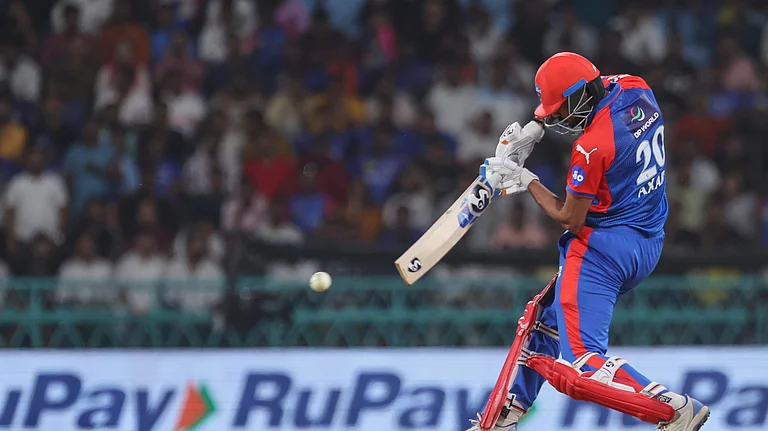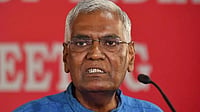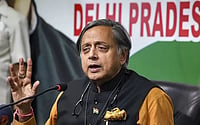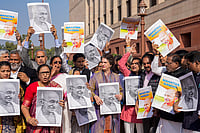THE seeds were sown, and the initial fruit reaped, by enterprising satellite television broadcasters down South. First it was Tamil. The result: roaring success after de rigueur teething problems. Then came Malayalam, Telugu and Kannada. Bull's eye once again. The little plant in the backyard is now a big tree and its branches are spreading in new directions. Gujarati is on the way. And Punjabi, Marathi and Bengali could well be next. Indeed, the language-niche channels, poised on the threshold of a major explosion, seems to be the way to go.
Vinay Kumar Jain realises that as well as anyone else. He is no Murdoch. He is not even a Subhash Chandra. Not as yet, at any rate. But he sure knows a winning formula when he sees one. That is precisely what his upcoming foray—a digitally compressed satellite TV channel exclusively in the Gujarati language—appears to be. "Our aim is to replicate the grand success of SUN TV in Tamil Nadu, Asianet in Kerala and Eenadu TV in Andhra Pradesh," says the managing director of Srishti VideoCorp, an integrated electronic media company that operates Channel YES (Youth Entertainment Service).
The proposed channel, YES Gujarati, one of six separate services that Srishti's digitally split transponder on IntelSat IS 704 can beam simultaneously, is scheduled to go on stream on June 17, the first anniversary of Channel YES. While the existing channel has had a rather chequered first 12 months primarily, as Jain explains, owing to the "severe cash crunch in the country", the new language service is expected to find its footing much more quickly than most new arrivals in India's crowded satellite TV scene have done so far.
"The worst is over and we are now ready to make new conquests," declares Jain. Apart from the inspiration provided by the positive outcome of a majority of the southern experiments, there is sound business logic behind the move to float a Gujarati channel. Consider the hard facts. According to the India Market Research Bureau, Gujarat has the highest number of cable TV connections in India—the state accounts for an estimated 20 per cent of the national total. Add to that the fact that over the past five years, the highly industrialised western Indian state has received more than Rs 10,000 crore as domestic and foreign investment. What that means in real terms is that the Gujarati community has one of the highest disposable incomes in the country. "Even if only 10 per cent of those who invest in Gujarat advertise on YES Gujarati, the channel will break even in the very first year," claims Jain.
That, indeed, has been the case virtually without exception with the leading regional language channels in the South as well. Udaya TV in Karnataka may have run into rough weather but, as most other players in the southern region have discovered to their delight, audience support and, consequently, advertising revenue are not difficult to corner if the lingo and programme content are right. Kalanidhi Maran, the low-profile but aggressive managing director of SUN TV, feels that the success of the language channels is a manifestation of the federal impulses that are inherent in India's democratic polity no less than the rise of regional political forces is. "Much like the federal polity itself, regional channels are an inevitability," he exults. He can afford to. The turnover of his Tamil channel registered an incredible 200 per cent jump in 1995-96—from Rs 15 crore to Rs 45 crore.
The thriving operation, backed by a staff strength of 200 and state-of-the-art pre-production and post-production facilities, now has two other channels on the platform—SUN Music and SUN Movies. Maran, of course, has an I-told-you-so air about him. "The centralised Doordarshan can never understand the needs of the people in a country as linguistically and culturally diverse as India. It will remain, by and large, a sarkari medium," he argues. In fact, Maran is convinced that even the privately-owned Zee TV, "a so-called national channel", is fundamentally regional in character. "Its success is confined only to the Hindi belt," Maran points out.
Tamil Nadu is swarming with language channels—Raj TV, Gemini TV, JJ TV, Vijay TV (which is owned by liquor baron Vijay Mallya)—but SUN has held its own against the competition. In sharp contrast, Kerala's Asianet and Andhra Pradesh's Eenadu TV (ETV) have faced no rivalry so far. But their growth over the past year has been no less spectacular. ETV was launched in August 1995 by media magnate Ramoji Rao's Eenadu Group and in under a year its penetration has doubled in Andhra Pradesh, which has seven crore Telugu-speaking people and well over 50 lakh TV-owning households. To begin with, ETV had a reach of 17 lakh homes. Today, that figure has spiralled to nearly 30 lakh. No wonder transnationals like Coca-Cola, Pepsi, Cadbury's and O'Clock are falling over each other to secure branding/naming rights to the channel's more popular programmes.
Isn't the time ripe for expansion? "We are in the process of consolidating our position at present," says A.S. Oberoi, the Telugu channel's marketing manager for northern India. ETV, which currently airs 18 hours a day, is all set to go round the clock "by the first or second week of June".
Speaking the language of the people and keeping them abreast of every little thing that has a bearing on their lives, as it did to great effect during the Lok Sabha and assembly elections, Asianet has carved out a niche for itself in Kerala. "The channel has become extremely popular among common Malayalees," says T.N. Gopa-kumar, Asianet's producer. The Malayalamchannel, which gave Doordarshan a run for its money during the coverage of the recent elections, is expected to gross over Rs 40 crore during the current financial year.
Not surprisingly, at Asianet ambitious expansion plans are on the anvil. Channel chief Sashi Kumar, who heads a team of 150 young TV professionals, has revealed in recent interviews that he will soon be launching a new Malayalam channel exclusively for residents of Kerala. The existing Asianet channel is meant not only for Malayalees living in the state, but also for the diaspora, especially in the Gulf. "It is impossible for any centralised channel to capture the vibrancy of the plurality of our country," says Gopakumar. "To be successful in the business of mass communication, one has to speak the language of the people, which is not Hindi for the majority of Indians."
But it's not language alone. Cultural predilections, too, play a significant role here. "Local forms of entertainment, performing arts and cinema," argues Gopakumar, "are vastly different from the Delhi-centric, Government-sponsored culture and the Bombay-based Hindi film culture. We are sensitive to this difference and hence successful."
Sensitivity to the average Gujarati TV viewer's cultural needs will be the guiding principle for Jain, too. "Gujaratis, like any other Indian linguistic group, are very proud of their culture and language. Justifiably so, after all Gujarat is rich in folk forms in the fields of art, music, theatre and literature. These are the forms that we will tap liberally for our channel," says Jain.
For many smaller advertisers, too, a language channel, with its concentrated viewership, offers a more viable platform than the national channels. "On YES Gujarati, for instance, a manufacturer who sells his products only in Gujarat doesn't have to pay through his nose to reach his specific target," says Jain.
So, as the whole wide world slips into our homes in the form of electronic images—countless, ceaseless, seamless—the satellite TV industry's focus seems to be shifting inwards: think local, act local is the new catch phrase.


























